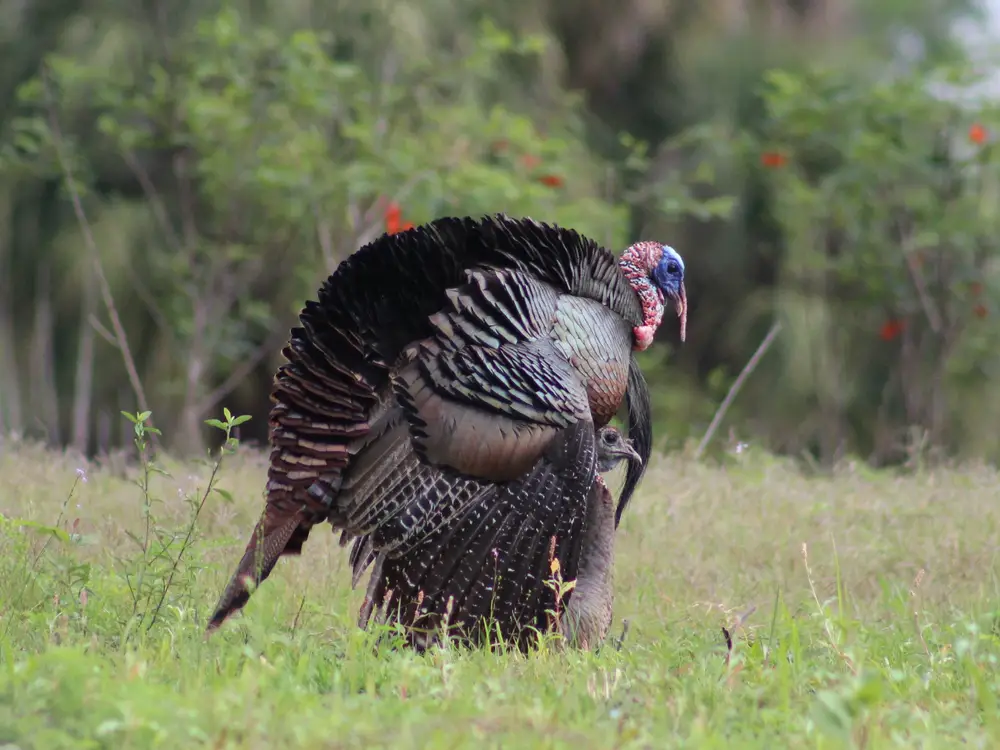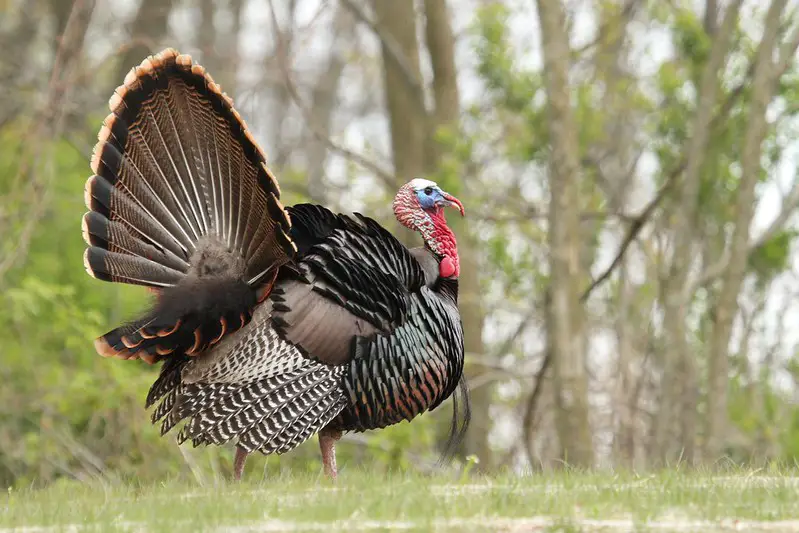Walmart must make a fortune selling turkey decoys to new turkey hunters. The big, colorful boxes with realistically colored decoys fill up more shelf space than any other product in the sporting goods aisle. But pick up a box, and you’ll learn that California says it’s dangerous to feed the turkey decoy to your family but nothing about how, when, and where to use it.
Turkey decoys are treated as impulse purchases. A product you decide to buy while waiting an hour for an employee to show up. Hopefully, it’s an employee that can use the hunting license machine and has a key to the ammo case.
You’d figure the turkey decoy manufacturers could at least print some “how to” info on the packaging. Surely they know a large percentage of their decoys will end up as deflated eyesores in a garage or set up in a location no real turkey would dare inhabit.
Related: Where to aim at a turkey.
Related: How to make a turkey food plot.

Turkey decoys must be set up using the correct decoy type in the right location, configuration, and numbers to match the current season’s turkey behavior. All four of these requirements will change as each season progresses.
Related: How to hunt turkeys in the rain.
Using turkey decoys in the spring.
If you live in turkey country, you know the extra time they add to your daily commute. Turkey flocks have their most significant numbers before the early season starts, and you spend a few minutes every few miles waiting for the turkeys to finish crossing the road.
Near the end of the early season, the flocks are much smaller. And that number decrease has little to do with careless drivers, coyotes, or the success rate of all the local turkey hunters. The flocks are smaller because the groups of hens, toms, and jakes have separated now that winter is over, and more areas provide suitable roosting places, food sources, and cover safety.
Related: How to find turkey roosts.
How to use turkey decoys in the first weeks of the season.
Using multiple turkey decoys is only safe during the season’s opening days. It’s what the turkeys expect to see now but will be highly wary about approaching later on—when such numbers are unnatural.
Setting up turkey decoys.
It is always a good idea to place every turkey decoy setup close enough to you (say a maximum of 20 yards away) just in case a tom starts to feel things are off and decides to hang up on you.
Related: A guide to calling turkeys.
The full strut turkey decoy scenario.
Many turkey hunting pros will use a full-strut turkey decoy early in the season. The reason they give is that the turkeys haven’t sorted out their pecking order yet. Nobody knows who the dominant bird is, so the fighting is constant. The males (still in groups that nearly overlap the hens) are never far away and constantly strutting.
However, another reason to use that full-strut turkey decoy is that the dang thing can be seen a mile away. Whether you spend $50 or $200, buy a cheap decoy or an expensive one, if it doesn’t get seen by the toms, you’ll get no action. And a reaction is what you want, so let’s talk about where to place a full strut turkey decoy in the first few weeks of the season.
The best place to put a full strut turkey decoy in the early season is where the hens feed. Place the decoy, along with one or two hen decoys, facing directly toward your shooting location and within a few yards of where the real hens will travel to reach their food source.
Now your full strut decoy is ready to lure whichever gobbler thinks he is the boss. The fewer dominant toms and jakes will likely pass on this too-dominate-looking bird.
Related: How to find a wounded turkey.
The feeder or laydown hen and jake decoy scenario.
While this is a great early-season turkey decoy setup, you must ensure your decoys are visible to the toms. Feeder and laydown hens and quarter strut decoys must be in well-lit areas with low grasses and little to no brush cover.
To set up this scenario, place one or two hens (adding a lookout hen is a nice touch and will complete the ruse) in a known hen feeding location. Face both hens in the same direction (toward you), then place the quarter strut about five yards behind them.
If you are after meat and don’t care about the size of fans, spurs, and beards, this is your choice scenario. Any Jake will feel confident in chasing off your decoy and having his way with these hens.
Related: What is the best time of day to go turkey hunting?
The full flock scenario.
This scenario should only be used very early in the season. Using half a dozen hen decoys in the first few weeks, before the hens split up and head for nesting spots and the jakes stop trailing them, will look much more natural to a tom at this moment in time.
Like every setup for turkey decoys, placing them close to and facing you is essential. Remember, you are in cover, and hens that appear to be heading toward cover are the ones a gobbler will pursue faster and more desperately.
Related: How to tell a jake from a tom.
Using turkey decoys during the mid to late season.
When the flocks have broken up into smaller groups, and the insects and other food sources can no longer support large numbers of turkeys, it’s time for you to reduce the number of turkey decoys you use.
Late in the season, the feeding hen turkey decoy can be used all by itself. The unlucky jakes, beaten up all season, are looking for one last chance to mate. These turkeys are suckers for a solitary hen and have no visible competition.
You can also often get away with using the full strut turkeys decoy. Your full strut decoy is still visible in the heavier foliage and small enough to entice a bully. The gobblers are getting desperate.
As things green up and grow, decoys become more challenging to see. Calling turkeys now becomes much more critical to your turkey hunting success. However, using decoys later in the season may not be worth the effort.
Related: Turkey nest locations and survival.

Are realistic turkey decoys worth the cost?
How and where you place your turkey decoys determines how successful your turkey hunt will be. Simply tossing an old turkey decoy down and moving off a few yards will do nothing for you. But, sometimes, correct placement, type, and numbers are not enough.
Sometimes, you need highly realistic, moving turkey decoys. Realism and movement can make all the difference, whether it’s a hung-up gobbler or the need to get within archery range.
As unnatural as a turkey decoy plopped down the middle of an open field may look, worse is the stiff as a board, motionless laydown hen buried in tall grass. It’s unnatural, and no gobbler is going to fall for it.
And if you are turkey hunting after opening day on public land, you are likely left with the smarter birds who will never fall for such a silly trick.
Related: Check out my favorite call maker, Rush Custom Callers’ turkey calls.
Adding motion to your turkey decoys.
Where it is legal, you can use a turkey decoy with a motion stake. Otherwise, you are left with the turkey-hunting version of “playing the wind.” Use a light enough decoy to be moved by a breeze, but stake it down to keep it from spinning like a top.
Adding some feathers or a full fan to your inexpensive decoy can make it appear a lot more life-like.
The last thing every turkey hunter needs when using turkey decoys is safety.
Use a bag to transport them in when moving through the woods and fields. The red, white, and blue colors and the realistic look of the turkey decoys are a potential hazard to you because that’s precisely what everyone else is looking for.
And always set up your turkey decoys in an open area, where other turkey hunters can see you as your work around them.
Turkey decoys be set up using the correct decoy type in the right location, configuration, and numbers to match the current season’s turkey behavior should help you bring in that trophy gobbler.
And the show you get to watch before you take the shot? It is amazing display that you will never forget.


